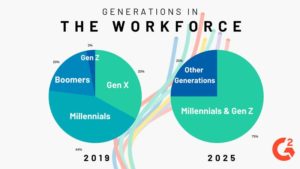
In a world of rapid change and corporate disruption, it is up to the leaders of the future to understand whether or not to accept the full potential of the multiple generations working together in their organisation.
Inclusion can help in creating a culture to empower the workforce to feel valued and confident.
Almost all the organizations today consist of five generations, but new generations are also joining the workforce now. These can be classified as follows based on their birth year –
- The Silent Generation (1925-1945)
- Generation Baby Boomers (1946-1964)
- Generation X (1965-1980)
- Generation K (1977-1987)
- Generation Y a.k.a. Millennials (1981-1994)
- Generation Z (1995-2000)
- Generation Alpha (2000-2015)
Each new generation adds a new perspective to the workforce. In the early days, the generational gap was huge but technological advancement has reduced the gap, which is why multiple generations are working together at the same time. This may result in conflicts in a workplace but it is up to modern business leaders to understand the opportunity they have been presented and work towards offering a better culture for the integration of multiple generations.
Great leaders have strong commitment and humility to create space for new talents while also demonstrating curiosity to understand and learn new things. They allow effective collaboration which empowers others.
Future-ready leaders embrace change and diversity – empowering collaborative, goal-directed young professionals to succeed in autonomous project teams. – Jennifer Vessels, Leader of Executive Growth Alliance.
If you dream of inclusive corporate culture and want to be future-ready for new generations in the workforce, let’s talk.
It is possible – through exploration, collaboration, learning and commitment to action – as demonstrated by many participants in the Executive Growth Alliance and Next Step clients.
